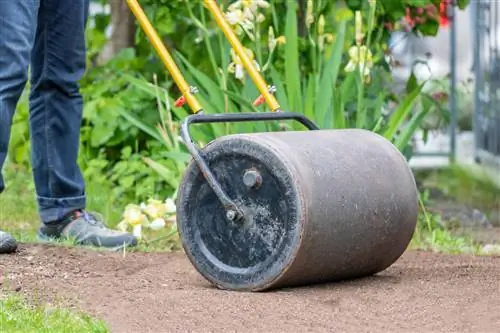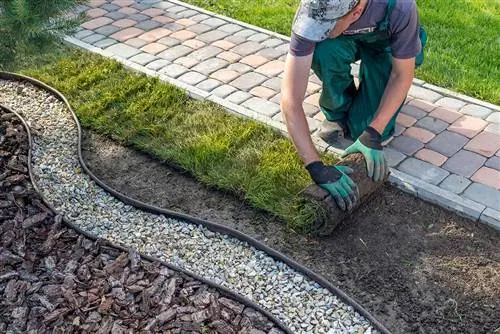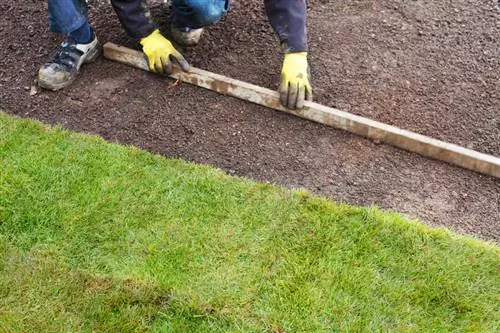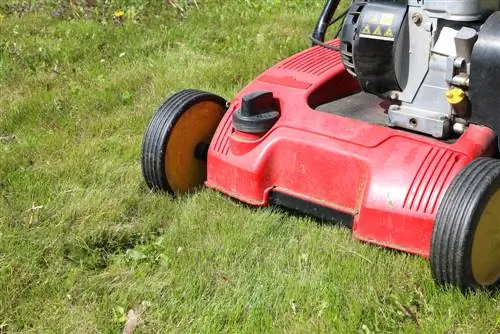- Author admin [email protected].
- Public 2024-01-05 20:48.
- Last modified 2025-01-23 11:19.
The lawn can be sown in spring or autumn. Before purchasing the lawn seeds, the correct location and subsequent use should be determined so that the seeds can germinate and form a dense turf.
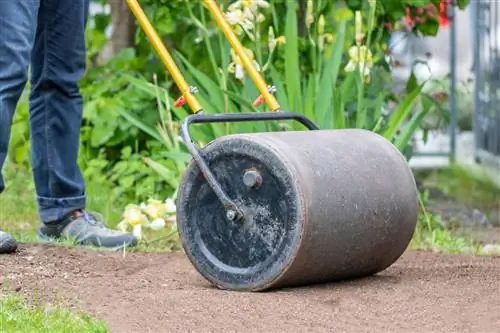
How to sow lawns?
New lawn is sown in spring or autumn. During these periods there are the best weather conditions for germination and growth of the lawn. Before actually sowing, it is advisable to remove the old turf and prepare the soil thoroughly.
Time of sowing
Ideal periods for sowing grass are spring betweenApril and Mayand autumn betweenend of August and OctoberDuring these periods, sufficient temperatures and natural irrigation through rain and humidity can be expected based on long-term weather comparisons.
Since a minimum temperature of ten degrees Celsius is required for germination, sowing in the winter months of November to March is not possible. Sowing from June to August is also not advisable due to the rapid evaporation caused by high temperatures.
Location and suitable seeds
The selection of seed mixtures in stores and on the Internet is very large. In addition to the well-known recreational lawns, there are also special mixtures for shady locations or the perfect ornamental lawn.
| Lawn seeds | Location | Usage | Costs |
|---|---|---|---|
| Sports and play turf | Sunny to partially shaded; loamy, sandy and humus soil | Use lawns, heavily used areas | approx. 7 €/Kg |
| ornamental lawn | Sunny, good soil with a high humus content | Greenery, no excessive burden | approx. 18 €/Kg |
| Golf grass | Sunny, good soil | Use lawn, high resilience | approx. 10 €/Kg |
| Dry lawn | Sunny to partially shaded, sandy and humus-poor soil | Use lawns, heavily used areas | approx. 20 €/Kg |
| Shaded lawn | Partly shaded to shady, balanced sand and clay content as well as humus | Use lawns, moderately trafficked areas | approx. 30 €/Kg |
| Parking lot lawn/gravel lawn | Sunny to shady, heavily compacted soil | Greenery, heavy soil | approx. 50 €/Kg |
Soil and substrate
Lawn is generally one of the more frugal plants and does not place great demands on the soil and substrate. However, when creating a lawn, attention should be paid to the correct soil conditions. This facilitates both germination and subsequent growth of the lawn.
The soil substrate should have sufficient water storage capacity and good permeability for liquids and air. The commercially available lawn soils offer an ideal composition. They usually consist of a mixture of expanded clay, wood fibers, sand and white peat. In addition, the mixtures usually contain a starter fertilizer that provides continuous fertilization over several weeks. This saves additional fertilizer application in the beginning.
If the soil is too fine-grained, up to 80% (optimally 30 to 40%) sand with a grain size of 0/4 can be incorporated into the top 15 cm. The sand grains that abut each other prevent the finer sand grains from being crushed together when they enter the surface. The principle works the other way around with pure sandy soil. A third of very well-seasoned compost can be incorporated here. (Source: Nature in the Garden)
Illustrated quick guide: Sowing the lawn
First, the existing turf is removed. Also remove stones, roots and sticks. The top 15 cm layer of soil is loosened and, if necessary, improved with sand or compost. The area is then leveled and the seeds are spread crosswise. The seeds are easily incorporated with a rake. Since the seeds germinate in light, they should not be completely covered with soil. After the final rolling of the area, watering is carried out evenly over a period of four weeks. The area should not be entered during this time. In addition to the removal of the grass seeds, the young stalks could suffer permanent damage from the strain. From a height of around eight centimeters, the first mowing is possible at the highest mowing setting (exclusive trimming of the tips), including entering the area.
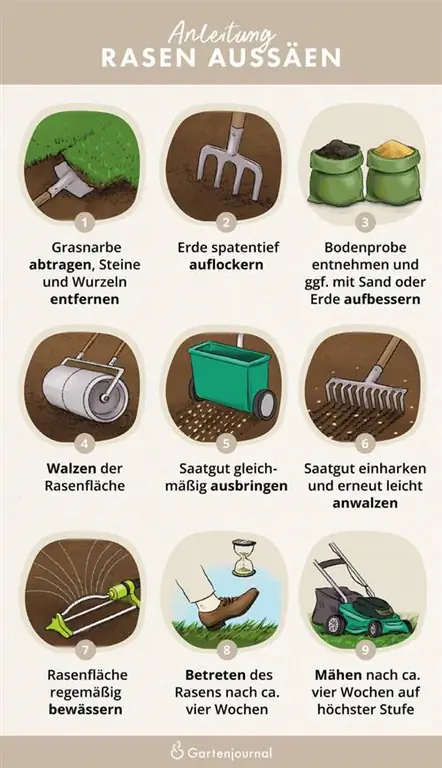
Detailed instructions: Sowing the lawn
Step 1: Remove the sod
In order to provide an ideal basis for the growth of the new lawn, the preparation of the surface is the be-all and end-all. To do this, it is necessary to remove the existing turf over a large area. This can be done either by hand or with mechanical assistance.
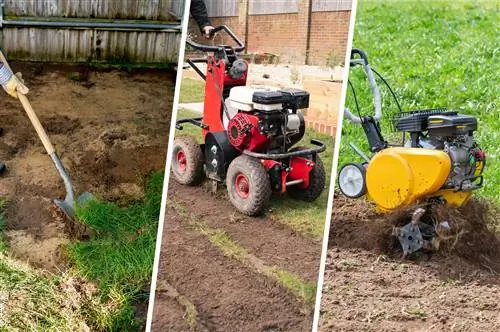
Three different variants have been established for removing the turf. In addition to manual removal using a spade (left), mechanical support such as the lawn peeler (middle) or the motor hoe (right) is also available for larger areas.
Removing the turf by hand
When removing by hand, the top turf is cut off with a spade. By cutting off rectangular pieces in a chessboard-like manner, the individual plots can be easily transported away. This option is cost-effective and requires no prior knowledge.
Remove sod mechanically
Compared to the manual method mentioned above, there are two working methods that require the use of machines. These are particularly suitable for creating large lawns.
Lawn peeler/sod cutter:Depending on the machine type, the sod is thrown out piecemeal or in strips that can be rolled up. With an average purchase price of between 250 and 350 euros, the lawn peeler is not exactly cheap. However, many hardware stores offer a rental service. The lawn peeler requires a surface that is as flat as possible to achieve optimal results. The machine can only handle hilly terrain inadequately. In this case, rework may be necessary.
Motor hoe:Instead of removing the turf in one piece or in part, it is chopped up and buried with motor-operated hoes. By tearing off the roots, the water and nutrient supply is prevented. However, in order to achieve complete death of the turf, a minimum depth of 15 centimeters and careful removal of all large root parts are required.
Step 2: Soil Preparation
In addition to removing weeds and other possible obstacles, optimal soil preparation also includes leveling the area. In addition, it is recommended to improve the soil quality in order to increase the resistance of the otherwise undemanding lawn seeds.
Step 2.1: Removing roots and stones
Any obstacle on or in the soil makes it difficult for seeds to germinate and grow. It is therefore advisable to clear the selected area of weeds, stones and roots. In this context, it is a good idea to dig the soil at least 15 cm deep. By using a motor hoe with the appropriate working depth, this step may be omitted. In any case, rubbish lying on the surface should be removed with a rake or rake.
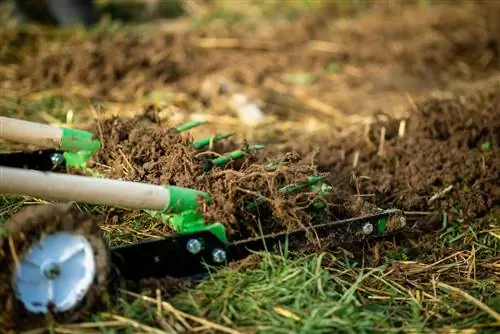
Root shoots located underground can take root again if they are not separated adequately and thus represent unwanted competition for the lawn.
Step 2.2: Improve soil
The extent to which it is necessary to apply new soil depends on the quality of the existing soil, but also on the method chosen for removing the turf. In particular, manual removal with a spade and the use of a lawn peeler require filling up the removed depth. In addition, it may be necessary to install a new turf base layer if the subsoil is too loose or too compacted. In both cases, germination and subsequent rooting of the seeds is made more difficult.
The following materials are suitable for building a new layer of earth:
- Compost
- Topsoil
- Sand
- Grass soil
In contrast to conventional topsoil, commercial grass soil already contains all the nutrients that the young lawn needs. Therefore, fertilization should be avoided in the first 10 to 12 weeks. In the worst case scenario, over-fertilization will occur, which can lead to the lawn dying.
Step 3: Sow the lawn
Lawn seeds are light germinators. After sowing, they may therefore only be covered with a very thin layer of soil (<1 centimeter), as the germination process may not begin. However, it is recommended to press the seeds lightly, for example with the back of a rake, to avoid them being washed away or blown away.
Step 3.1: Sowing
In addition to spreading seeds by hand, spreaders and seed drills have also become established for larger areas. Before starting work, the soil should be slightly moistened. This can be done either by rain or a lawn sprinkler and improves the adhesion and supply of the seeds. Under no circumstances should waterlogging have formed on the surface. In this case, loosening the soil again is recommended.
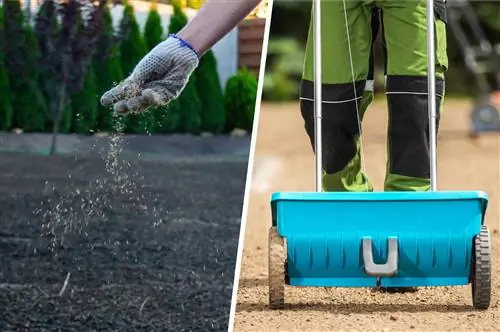
Spreading the seeds by hand requires some practice to achieve an even density. Spreading wagons and seed machines are available as technical support.
Sowing the lawn by hand:Sowing by hand does not require any additional tools. For uniform germination, the most precise application possible is required. When sowing by hand, this is only possible with appropriate practice. Beginners can gain their first experience with spreading sand. Before starting work, the amount of seed required for the desired area should be carefully weighed. A corresponding recommendation is usually stated on the back of the packaging. The seeds are then sown in portions. For particularly large areas, it is recommended to divide the seeds into smaller segments to ensure even distribution.
Sowing lawns by machine:
Hand spreaders are also very popular for evenly distributing the fertilizer. By adjusting the spreading strength, the application rate can be adjusted individually. By driving crosswise over the surface, a particularly dense result is achieved without causing matting. This is often caused by sowing quantities that are too high because the individual seedlings have too little space. The optimal setting can be determined by atest drive:
- Cover the floor with foil or tarpaulin (at least one square meter)
- Fill the spreader wagon with seeds
- Cover the area of one square meter
- collect and weigh the sown seeds in a bowl
- Compare measurement result with manufacturer’s information
- Correct the spread amount up or down if necessary
Step 3.2: Attachment
After the lawn seeds have been sown, they should be attached to the substrate. For smooth germination, the seeds need direct contact with the soil. It is recommended to use an aid to press the seeds evenly. Due to the existing profile, conventional shoes are not suitable for the work. Instead, use board shoes or a lawn roller.
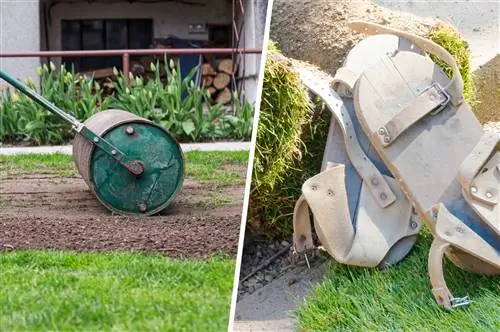
After sowing the lawn seeds, they should be pressed lightly. This is ideally done with a lawn roller or a board.
Lawn roller:The lawn roller is the most common device for fixing substrates. Thanks to the large rolling surface, larger areas can also be processed. Depending on the thickness and weight of the roller, however, some muscle strength is required as the lawn roller is operated exclusively by hand. You can find a clear buying guide with recommendations from the editors here. With a little skill, an old rain barrel can also be converted into a roller.
Board shoes:Board shoes have no profile, unlike normal shoes. Instead, their underside is covered with a straight board. This achieves a similar, even grip to that of the lawn roller. However, due to the smaller contact area, this method is more suitable for smaller areas.
Board shoes as an alternative are easy to recreate. You will find detailed instructions in the following video.

Step 3.3: Reseeding
Despite all the care when creating new lawns, it can happen that not all areas germinate and grow equally well. In these cases, it is recommended to reseed the free areas. The ideal times for reseeding areSpringandAutumn
Please note the following:
- Mow the surrounding lawn as short as possible
- clear free areas of weeds
- Spread seeds evenly
- Press seeds lightly
- moisten well for about two weeks and do not walk on it
Tip
You can do without expensive lawn soil for small reseeding. Commercially available potting soil is also suitable here.
Step 4: Caring for the lawn
Both the seedlings and young blades of grass are very sensitive. In addition to external influences, drought stress is a common cause of the death of new lawns. Below we will explain the most important key points for proper lawn care.
Step 4.1: Water the lawn after sowing
Both the seeds and the young seedlings do not yet have a developed water storage organ. That's why continuous irrigation is essential, especially in the firsttwo to three weeks after sowing. In the rainy months of April, September and October, additional watering is not necessary. However, excessive moistening of the surfaces can lead to the seeds being washed out or moldy.
Step: 4.2: Protect the lawn and do not walk on it
The young blades of grass are not yet strong enough due to their delicate structure. The area should not be walked on until the first mow after about four weeks. This ensures complete root penetration of the individual stalks and thus increases stability.
Step 4.3: Mowing the lawn for the first time
The lawn can be mowed for the first time when it iseight to ten centimeters high. It usually takes the seeds about a month to reach this height. At this point, the turf is usually not yet completely closed. However, repeated mowing continually stimulates the closure of the turf. At the beginning it is advisable to leave the lawnmower on the highest setting and only trim the upper shoot tips. As the lawn gets older, the cut can become shorter.
Step 4.4: Fertilize the lawn for the first time
The time of the first fertilization depends primarily on the soil used. With conventional soil, a long-term lawn fertilizer should be applied after the first cut. However, if the soil has been prepared with turf soil, the first separate fertilization can take place later. With the starter fertilizer, the lawn is optimally supplied with nutrients for at least two months. In this case, top-fertilization is also recommended after three months at the latest. You can find an overview of the correct selection of a fertilizer and its application in this article.
Under no circumstances should fertilization be avoided, as it is an essential basis for the even closure of the turf and he althy growth.
Instructions: Sowing new seeds on old lawn
Especially when the lawn area declines due to increasing moss, the question arises to what extent new lawn seed material can be applied to the already planted area. This question can initially be answered with a clear yes. However, in order to achieve an even and attractive result with a manageable amount of time and effort, there are a few essential steps to consider.
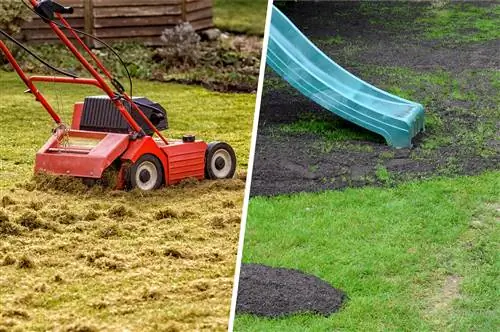
Dethatching and spreading new substrate on fallow areas is a prerequisite for new sowing on old lawn.
Instructions
- Mow existing lawn as short as possible
- Thorify the lawn thoroughly in the lengthwise and crosswise directions.
- Remove scarifying material regularly
- Spread lawn soil as a basis for new seeds
- Spread seeds by hand or with a spreader and press lightly
- Water well
Within two to four weeks, with sufficient temperatures of at least ten degrees Celsius, a he althy new layer of grass will form. At a height of around eight centimeters, the lawn can be used for the first time at the highest mowing level.
You can find instructions with further helpful tips in the following video.

Rolled turf or lawn seed?
If you want to green up an area at short notice, sooner or later you will think about using turf. Because the seeds have already been pre-germinated, the grass-covered strips are almost ready to be laid on the corresponding area. On average, the lawn is fully resilient after just two to three weeks. During this time, the grass seed has just germinated under favorable weather conditions. A major advantage of using turf is the time factor.
However, the material costs are significantly higher compared to sowing. While commercial seeds are available for around 1 - 3 EUR/m², amounts between 5 and 10 EUR/m² are charged for the turf alone. In addition, there are costs for planning and laying of 20 to 50 EUR/m² for rolled turf. The costs for irrigation, fertilization and leveling incurred in both variants are not taken into account in this analysis.
Taking all cost items into account, sowing lawn seeds is significantlycheaper than laying turf. In principle, it is possible to save cost items by doing your own work. However, since laying turf requires a certain amount of know-how, laypeople should avoid this option. If you still plan to lay your turf yourself, we recommend these instructions. Sowing the areas requires a longer time horizon, but smaller errors can be rectified much more easily.
FAQ
How to sow lawns?
In addition to removing the old turf, weeds, stones and other obstacles should be removed. The subsequent loosening and leveling of the soil provides the seeds and seedlings with an optimal substrate. The selected seeds can then be distributed evenly using a spreader, a seed drill or by hand.
When is lawn sown?
Lawn seeds need sufficient light, moisture and warmth to germinate. The ideal sowing times are April and May as well as August to October. In the remaining months the conditions for sowing are rather unsuitable.
Is laying turf better than sowing lawn?
Rolled turf offers the advantage of significantly faster greening and loading of the area. However, this is associated with comparatively higher costs than sowing. The latter requires a time horizon of at least ten to twelve weeks to achieve a comparable result.
Can new lawn be sown on old lawn?
Before new lawn can be sown on an already planted area, the area must be prepared. First, the lawn should be mowed and scarified as short as possible. Before the exposed areas are sown with new lawn seeds, they must be cleared of weeds and other debris and covered with new soil. The seeds are then distributed evenly and pressed lightly.
How much does it cost to sow lawn?
The costs for sowing lawns are between 1 and 3 euros per square meter. The price range results from the different qualities of the seed mixtures and their areas of application. When choosing the right seeds, pay attention to the desired area of application and high-quality raw materials.

